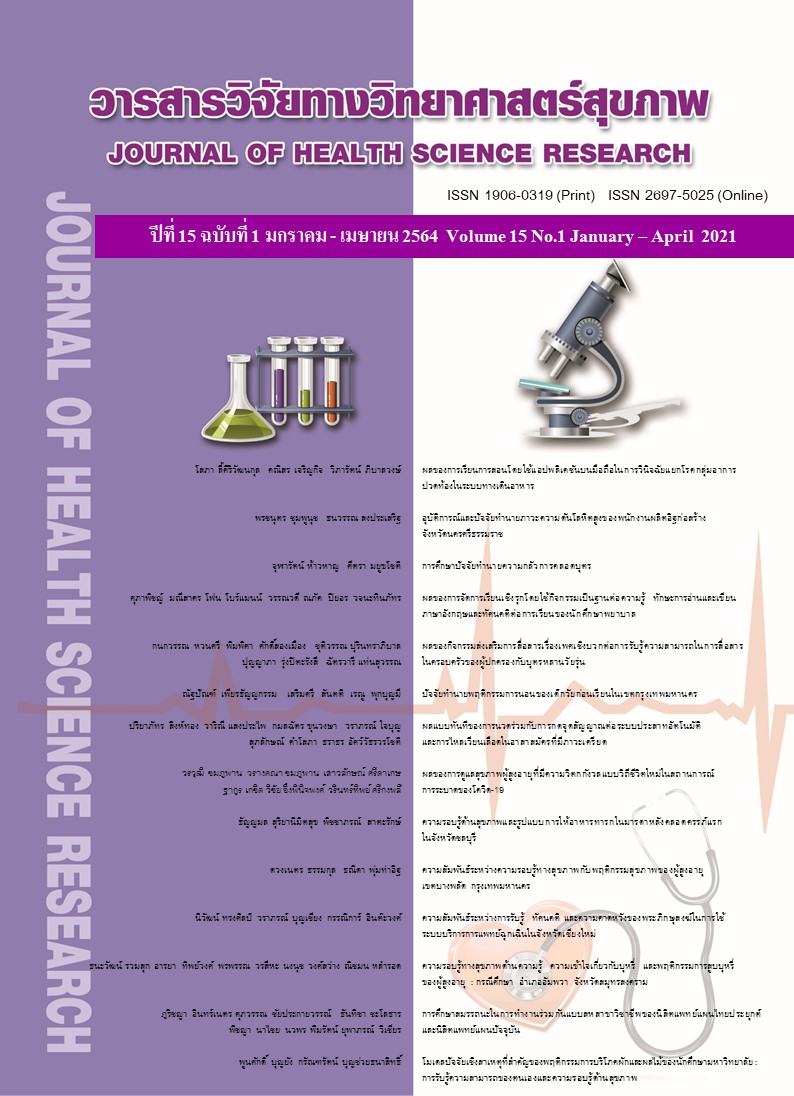ผลของการดูแลสุขภาพผู้สูงอายุที่มีความวิตกกังวล แบบวิถีชีวิตใหม่ในสถานการณ์การระบาดของโควิด-19
Main Article Content
บทคัดย่อ
บทนำ : การเพิ่มขึ้นของประชากรสูงวัยเกิดขึ้นทั่วโลก เช่นเดียวกับประเทศไทยที่พบว่า ภาคตะวันออกเฉียงเหนือมีจำนวนผู้สูงอายุมากที่สุด ผู้สูงวัยจะมีการเปลี่ยนแปลงด้านอารมณ์ ส่งผลให้มีความวิตกกังวลได้ง่าย ส่วนใหญ่สาเหตุมาจาก การเจ็บป่วย ภาวะพึ่งพิง หากมีแนวทางใหม่ในการดูแลผู้สูงอายุในชุมชน เพื่อผ่อนคลายความวิตกกังวล โดยเฉพาะอย่างยิ่งในสถานการณ์ที่มีการระบาดของ
โควิด-19
วัตถุประสงค์การวิจัย : เพื่อศึกษาผลของโปรแกรมการดูแลสุขภาพผู้สูงอายุที่มีความวิตกกังวลต่อความวิตกกังวล ความปวด ความดันโลหิต และอัตราการเต้นของหัวใจ
วิธีการวิจัย : การวิจัยกึ่งทดลองสองกลุ่มวัดผลก่อนและหลังการทดลอง ตัวอย่างคือ ผู้สูงอายุที่มีความวิตกกังวลที่อาศัยในชุมชนในเขตจังหวัดขอนแก่น โดยแบ่งเป็นกลุ่มทดลองและกลุ่มเปรียบเทียบกลุ่มละ 36 ราย กลุ่มทดลองได้รับโปรแกรมการดูแลสุขภาพนาน 3 เดือน เก็บรวบรวมข้อมูลก่อนและหลังการทดลอง โดยใช้แบบวัดความวิตกกังวล แบบวัดความปวด แบบการวัดความดันโลหิต และแบบการวัดอัตราการเต้นของหัวใจ วิเคราะห์ข้อมูลโดยการเปรียบเทียบค่าเฉลี่ยของข้อมูลภายในกลุ่มและระหว่างกลุ่มด้วยสถิติทดสอบที
ผลการวิจัย : พบว่า กลุ่มทดลองมีคะแนนเฉลี่ยความวิตกกังวลลดลง 7.17 คะแนน (95%CI = 5.11 - 9.22) (p <.001) และยังพบว่า ความปวด ความดันโลหิต และอัตราการเต้นของหัวใจแตกต่างจากก่อนการทดลอง และแตกต่างจากกลุ่มเปรียบเทียบอย่างมีนัยสำคัญทางสถิติ
สรุปผล : โปรแกรมการดูแลสุขภาพผู้สูงอายุที่มีความวิตกกังวล มีผลต่อการลดลงของความวิตกกังวล ความปวด ความดันโลหิต และอัตราการเต้นของหัวใจ
Downloads
Article Details
บทความที่ได้รับการตีพิมพ์เป็นลิขสิทธิ์ของวิทยาลัยพยาบาลบรมราชชนนี จังหวัดนนทบุรี
ข้อความที่ปรากฏในบทความแต่ละเรื่องในวารสารวิชาการเล่มนี้เป็นความคิดเห็นส่วนตัวของผู้เขียนแต่ละท่านไม่เกี่ยวข้องกับวิทยาลัยพยาบาลบรมราชชนนี จังหวัดนนทบุรี และคณาจารย์ท่านอื่น ในวิทยาลัยฯ แต่อย่างใด ความรับผิดชอบองค์ประกอบทั้งหมดของบทความแต่ละเรื่องเป็นของผู้เขียนแต่ละท่าน หากมีความผิดพลาดใด ๆ ผู้เขียนแต่ละท่านจะรับผิดชอบบทความของตนเองแต่ผู้เดียว
เอกสารอ้างอิง
United Nations, Department of Economic and Social Affairs, Population Division: World Population Ageing 2019 Highlights; 2019.
Foundation of Thai Gerontology Research and Development institute (TGRI): Situation of the Thai Elderly 2018. Bangkok: Deuan Tula Printing House; 2019. (in Thai).
Chompoopan W, Chompoopan W, Eungpinichpong W, Eungpinichpong W. Effects of low intensity exercises on body balance and muscle strength of community elderly people. Int J GEOMATE. 2019;17(61):86-90. doi: 10.21 660/2019.61.4786.
Bureau of Elderly Health, Report of Thai Elderly Survey 2013. Department of Health, Ministry of Public Health, Thailand. Bangkok: Vatcharin P.P.; 2013. (in Thai).
Land KC, Michalos AC. Fifty years after the social indicators movement: Has the promise been fulfilled? Soc Indic Res. 2018;135(3):835-68. doi: 10.1007/s1120 5-017-1571-y.
Paltasingh T, Tyagi R. Caring for the Elderly: Social Gerontology in the Indian Context: SAGE Publications, New Delhi, India; 2015.
Havighurst RJ, Albrecht R. Older people. New York: Longmans, Green; 1953.
Andrews G, Hobbs MJ, Borkovec TD, Beesdo K, Craske MG, Heimberg RG, et al. Generalized worry disorder: a review of DSM-IV generalized anxiety disorder and options for DSM-V. Depress Anxiety. 2010;27(2):134-47.doi: 10.1002/da.20658.
Welzel FD, Stein J, Röhr S, Fuchs A, Pentzek M, Mösch E, et al. Prevalence of anxiety symptoms and their association with loss experience in a large cohort sample of the oldest-old. Results of the AGECODE/AGEQUALIDE study. Front Psychiatry. 2019;10:285. doi:10.3389/fpsyt. 2019.00285.
Eden J, Maslow, K, Le M, Blazer D. The mental health and substance use workforce for older adults: In whose hands? Committee on the Mental Health Workforce for Geriatric Populations, Board on Health Care Services; Institute of Medicine. Washington, DC. National Academies Press; 2012.
Zhang X, Norton J, Carrière I, Ritchie K, Chaudieu I, Ancelin M-L. Generalized anxiety in community-dwelling elderly: prevalence and clinical characteristics. J Affect Disord. 2015;172:24-9. doi: 10.1016/j.jad.2014.09.036.
Suradom C, Wongpakaran N, Wongpakaran T, Lerttrakarnnon P, Jiraniramai S, Taemeeyapradit U, et al. Prevalence and associated factors of comorbid anxiety disorders in late-life depression: findings from geriatric tertiary outpatient settings. Neuropsychiatr Dis Treat. 2019;15:199-204. doi: 10.2147/ND T.S184585.
de Heer EW, Gerrits MM, Beekman AT, Dekker J, van Marwijk HW, de Waal MW, et al. The association of depression and anxiety with pain: a study from NESDA. PloS one. 2014;9(10):e106907. doi: 10.13 71/journal.pone.0106907.
Bandelow B, Michaelis S, Wedekind D. Treatment of anxiety disorders. Dialogues Clin Neurosci. 2017;19(2):93-107. doi: 10.31887/DCNS.2017.19.2/bbandelow.
Chompoopan W, Eungpinichpong W, Eungpinichpong W. Effects of traditional thai massage on heart rate, blood pressure, and anxiety in depression patients: A pilot study. Int J Geomate. 2016;11(28):2892-5.
doi: 10.21660/2016.28.1360.
Uratanamnee S, Lerdsamran S. Stress anxeity and depression of high school
teenager in preparation for university admission: The journal of psychiatric nursing and mental health. 2017;31(2):78-94. (in Thai).
Pinar R, Afsar F. Back Massage to Decrease State Anxiety, Cortisol Level, Blood Prsessure, Heart Rate and Increase Sleep Quality in Family Caregivers of Patients with Cancer: A Randomised Controlled Trial. Asian Pac J Cancer Prev. 2015;16(18):8127-33. doi: 10.7314/apjcp.2015.16.18.8127.
Yücel ŞÇ, Arslan GG, Bagci H. Effects of hand massage and therapeutic touch on comfort and anxiety living in a nursing home in turkey: A randomized controlled trial. J Relig Health. 2020;59(1):351-64. doi: 10.1007/s10943-019-00813-x.
Furlan AD, Giraldo M, Baskwill A, Irvin E, Imamura M. Massage for low‐back pain. Cochrane Database Syst Rev. 2016(9). doi: 10.1016/j.explore.2016.02.014.
Nelson NL. Massage therapy: understanding the mechanisms of action on blood pressure. A scoping review. J Am Soc Hypertens. 2015;9(10):785-93. doi: 10.1016/j.jash.2015.07.009.
Kaye AD, Kaye AJ, Swinford J, Baluch A, Bawcom BA, Lambert TJ, et al. The effect of deep-tissue massage therapy on blood pressure and heart rate. J Altern Complement Med. 2008;14(2):125-8. doi: 10.1089/acm.2007.0665.
Freitas SR, Mendes B, Le Sant G, Andrade RJ, Nordez A, Milanovic Z. Can chronic stretching change the muscle-tendon mechanical properties? A review. Scand J Med Sci Sports. 2018;28(3):794-806. doi: 10.1111/sms.12957.
Hartley S, Raphael J, Lovell K, Berry K. Effective nurse-patient relationships in mental health care: A systematic review of interventions to improve the therapeutic alliance. Int J Nurs Stud. 2020;102:103490. doi: 10.1016/j.ijnurstu.2019.103490.


